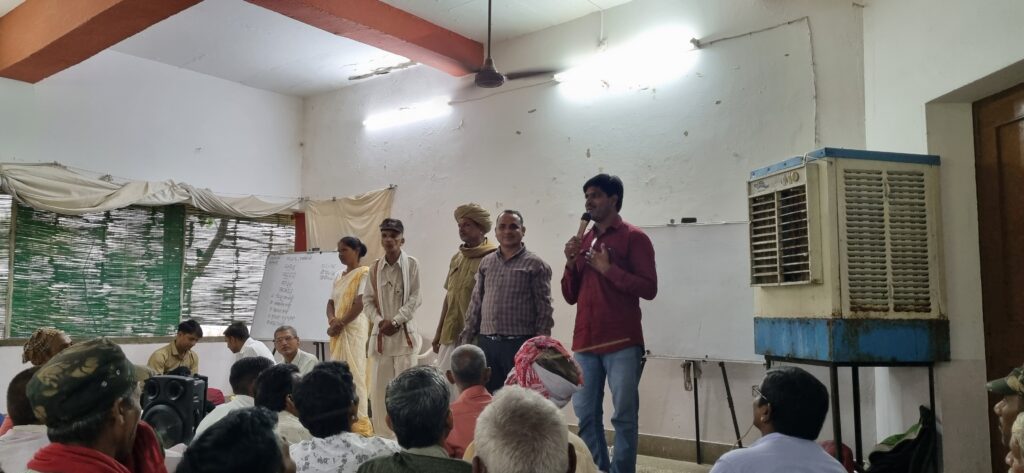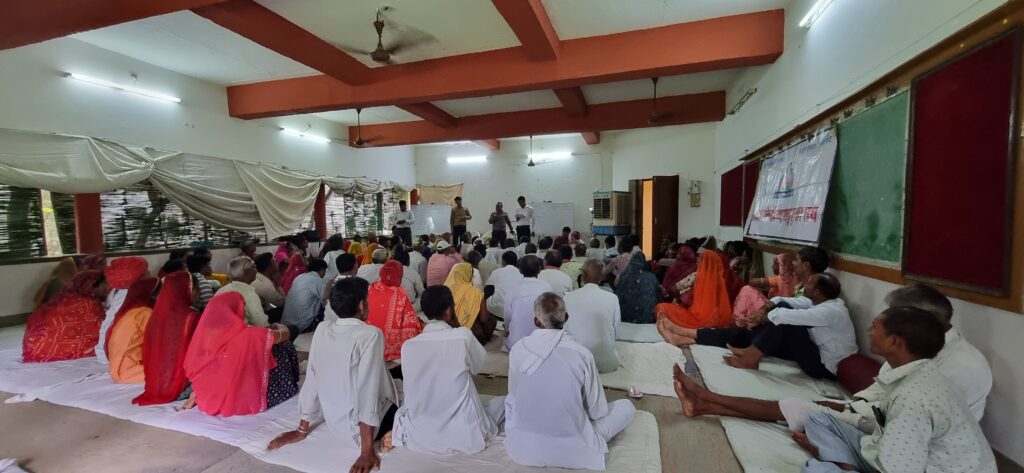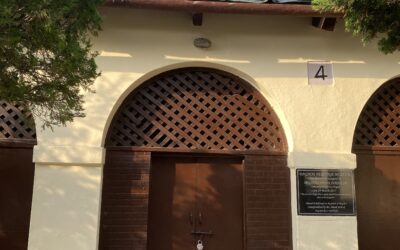I found myself face to face with the most generic scenario that one witnesses across elections – are all the candidates even known to the voters? I had the opportunity to observe and participate as a facilitator in the union elections of the Aravali Nirman Majdoor Suraksha Sangh. It is a labour union comprising mostly of construction workers based out of southern Rajasthan.
Day 1: Setting The Stage For Union Elections
It was around noon when I arrived at the Aastha training centre, a space often used by the union for its larger meetings in Udaipur. The General Body Meeting (GBM) is a two-day event where members discuss the union’s current state of affairs. What has the journey been so far, and what is the path forward? Unbeknownst to some, including me, the second half of the second day was reserved for the union elections.
A special guest had been invited to help facilitate the discussions and help them understand the structure and the system under which they work, how oppressive it is, and what role the collective will have to play to break out of it. He also talked about the external factors that could create hindrances in achieving the said objective.

Diverse Opinions And Debates
Aajeevika Bureau works closely with the labour union, providing them with outward support and guidance. As members started to arrive, there were lively greetings and conversations, with many representatives from different centres seizing the chance to catch up.
Also Read: Towards A Peaceful Revolution To Bring Dignity to Labor Migration
To my surprise, while members were enthusiastic about the big event, i will not lie, many were also unaware of the meeting’s key agenda. We started at around 2PM with over 100 members in total, representing a union of more than 12,000. The discussion and debate over various concerns continued throughout the day. By the end of the day one, there was a lot of information to assimilate and fatigue was setting in. It was an apt time to wrap.
The discussions ranged from caste and gender issues to labour rights and patriarchy. Tensions rose as members debated the roles of men and women in the workplace. While heated, these debates highlighted the very real struggles the workers face every day.
Day 2: Priorities Amidst An Unconventional Election
The second day began with group presentations. Last day, members were divided into ten-person groups. They presented their ideas on the Union’s top five priorities in the coming decade. The time allotted for these presentations swiftly passed. The union elections would begin after lunch. With 11 posts to fill, including the president, members returned to their seats quite swiftly. Up until then, I had only been an observer, but I was shortly invited to serve as a facilitator for the election.
The Incumbent Chairman’s Address
Before the union elections began, the incumbent chairman, who had been in the role for eight years, took the microphone. He reflected on his time in office, highlighting the collective’s successes over the years and how they have continued or progressed during the course of his term. He also discussed the union’s future issues, including the need to find newer and more creative solutions to its day-to-day problems.
His brief statement ended with a surprise: he indicated a desire not to run for another term. He contended that Aravali requires new leadership to guide them with renewed zeal and excitement. Several members reacted strongly to his remark, pushing him to reconsider and continue in his post for another two-year term.

The Moment Of Truth
The facilitators and the incumbent chairman, Govindji, laid out the election procedure for the members. Members, now in the role of voters, were asked to suggest candidates for open positions beginning with the president, but the response was, to my discomfort was lukewarm. Perhaps the ideas of carries of charged up unions had created a single story in my mind and the reality, often more complex and layered was not seeming as ‘interesting’.
Very few people seemed interested in running for the top job. Some members whose names had been recommended or endorsed by others also were hesitant.
Interestingly, after some encouragement from the coordinators and senior union members, three candidates emerged. Two were nominated by the coordinators and one who appeared to be enthusiastic about his prospects and had put his hat in the ring himself. His self-nomination could have been motivated by his previous experience as union president. Govindji was eventually requested or rather urged, to put his name back on the ballot. Despite his initial reluctance, he complied without much resistance. The members applauded as soon as his name was scribbled on the whiteboard, indicating where the majority of their support rested or was leaning.
In the end, there were four, but what happened next was even more astonishing. Each was given a few minutes to explain why they should be elected president. One of the candidates, after delivering a good speech, sought to withdraw from the contest and publicly voiced his support for the incumbent president.
Results
The other two candidates, judging from voter reactions, did not inspire much confidence, and then there was Govindji himself. He spoke for almost 5 minutes and received dozens of applauses. The names of all the candidates were written on the whiteboard, and chits were distributed to each member. They were given some time to write the name of their preferred candidate and place it in the ballot box. If someone had trouble writing the name, facilitators would write it for them.
As in the case in elections, amusing things did follow suit! Some senior members strongly advocating for a particular candidate above others. Others with whom I interacted urged me to pick a candidate for them, admitting that they were unaware of the running candidates. By the time the remaining positions were up for vote, most people were again tired out and beginning to worry about the return journey. The voting process shifted into a “yes” or “no” procedure and was completed sooner. Govindji received 87 of the 109 votes and was re-elected as president.
Reflections
As the day came to an end, I was at a loss for words regarding what I had witnessed. Many things were running through my mind. Before jumping to conclusions, I had to acknowledge that I was unfamiliar with the union’s structure and operations. However, I still had many questions. Not all of them were comfortable ones.

This election was more than a procedure for me who is new and is trying to absorb it all. It was a reflection of the deeper challenge which collectives continuously have to challenge and break – the status quo.
One idealizes, from what we witness in media and movies – such processes being epitome of all our universal values like inclusivity, participation, tonnes of energy oozing, celebrations and heartbreaks, open confrontations and lengthy charged up speeches. The recently concluded general assembly elections will remind you of such imagery as well.
It will take me time to process that what i witnessed here, on the other hand, appeared cautious and change resistive. An optimistic hat response is that it indicated things going too well in the current leadership and hence hesitation to switch – even when the leader expressed their desire for the same. Is it not a sign of deep stability and faith in the leadership? Perhaps also a recognition of how complex the demands of the role could be?
It is always a tricky one to say, like in a cricket finale, is it better to retain a winning combination or make quirky changes like an additional spin bowler while resting the reliable all rounder.
The critique in me of course nudges me to have a long list of concerns, most of it action items. How does one reignite passionate dialogue in collectives? What can lead to more participation in general body meetings be inspired? How do we design better governance structures and processes which naturally brings about leadership diversity and distribution, without the need for some to be exceptional or load bearing? My fellowship journey has just begun and i look forward to fuelling this reflective space with ideas and actions that we take in this direction.




0 Comments